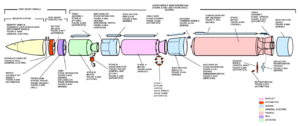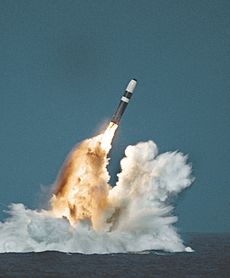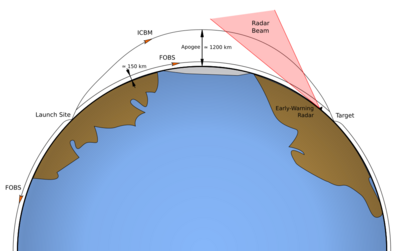Ballistic missile facts for kids
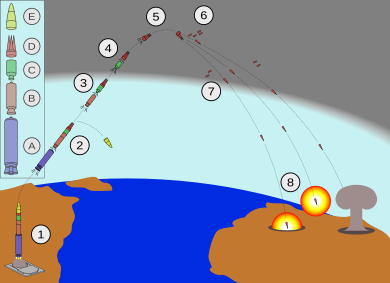
- 1. The missile launches out of its silo by firing its 1st-stage boost motor (A).
- 2. About 60 seconds after launch, the 1st-stage drops off and the 2nd-stage motor (B) ignites. The missile shroud (E) is ejected.
- 3. About 120 seconds after launch, the 3rd-stage motor (C) ignites and separates from the 2nd stage.
- 4. About 180 seconds after launch, 3rd-stage thrust terminates and the post-boost vehicle (D) separates from the rocket.
- 5. The post-boost vehicle maneuvers itself and prepares for re-entry vehicle (RV) deployment.
- 6. The RVs, as well as decoys and chaff, are deployed.
- 7. The RVs (now armed) and chaff re-enter the atmosphere at high speeds.
- 8. The nuclear warheads detonate.
A ballistic missile (BM) is a type of missile that uses projectile motion to deliver warheads on a target. These weapons are powered only during relatively brief periods—most of the flight is unpowered. Short-range ballistic missiles (SRBM) typically stay within the Earth's atmosphere, while most larger missiles are exo-atmospheric. The largest ICBMs are capable of full orbital flight. These weapons are in a distinct category from cruise missiles, which are aerodynamically guided in powered flight and thus restricted to the atmosphere.
Contents
History
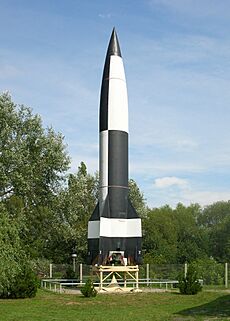
One modern pioneer ballistic missile was the A-4, commonly known as the V-2 developed by Nazi Germany in the 1930s and 1940s under the direction of Wernher von Braun. The first successful launch of a V-2 was on October 3, 1942, and it began operation on September 6, 1944, against Paris, followed by an attack on London two days later. By the end of World War II in Europe in May 1945, more than 3,000 V-2s had been launched.
The R-7 Semyorka was the first intercontinental ballistic missile.
Flight
An intercontinental ballistic missile trajectory consists of three parts: the powered flight portion; the free-flight portion, which constitutes most of the flight time; and the re-entry phase, where the missile re-enters the Earth's atmosphere. The flight phases for shorter-range ballistic missiles are essentially the first two phases of the ICBM, as some ballistic categories do not leave the atmosphere.
Ballistic missiles can be launched from fixed sites or mobile launchers, including vehicles (e.g., transporter erector launchers), aircraft, ships, and submarines. The powered flight portion can last from a few tenths of seconds to several minutes and can consist of multiple rocket stages.
When the fuel is exhausted, no more thrust is provided and the missile enters free flight. In order to cover large distances, ballistic missiles are usually launched into a high sub-orbital spaceflight; for intercontinental missiles, the highest altitude (apogee) reached during free-flight is about 4,500 kilometers (2,800 mi).
The re-entry stage begins at an altitude where atmospheric drag plays a significant part in missile trajectory, and lasts until missile impact. Re-entry vehicles re-enter the Earth's atmosphere at very high velocities, on the order of 6–8 kilometers per second (22,000–29,000 km/h; 13,000–18,000 mph) at ICBM ranges.
Types
Ballistic missiles vary widely in range and use, and are often divided into categories based on range. Various schemes are used by different countries to categorize the ranges of ballistic missiles:
- Air-launched ballistic missile (ALBM)
- Tactical ballistic missile: Range from about 150 to 300 kilometres (93 to 186 mi)
- Theatre ballistic missile (TBM): Range from 300 to 3,500 kilometres (190 to 2,170 mi)
- Short-range ballistic missile (SRBM): Range from 300 to 1,000 kilometres (190 to 620 mi)
- Medium-range ballistic missile (MRBM): Range from 1,000 to 3,500 kilometres (620 to 2,170 mi)
- Intermediate-range ballistic missile (IRBM) or long-range ballistic missile (LRBM): Range from 3,500 to 5,500 kilometres (2,200 to 3,400 mi)
- Intercontinental ballistic missile (ICBM): Range greater than 5,500 kilometres (3,400 mi)
- Submarine-launched ballistic missile (SLBM): Launched from ballistic missile submarines (SSBNs)
Long- and medium-range ballistic missiles are generally designed to deliver nuclear weapons because their payload is too limited for conventional explosives to be cost-effective in comparison to conventional bomber aircraft.
Quasi-ballistic missiles
A quasi-ballistic missile is a category of SRBM that is largely ballistic but can perform maneuvers in flight or make unexpected changes in direction and range. Large guided MLRS rockets with range comparable to an SRBM are sometimes categorized as quasi-ballistic missiles.
List of quasi-ballistic missiles
- Shaurya (active)
- Pralay (active)
- LORA (active)
- Iskander (active)
- MGM-140 ATACMS (active)
- Precision Strike Missile (under development)
Hypersonic ballistic missile
Many ballistic missiles reach hypersonic speeds (i.e. Mach 5 and above) when they re-enter the atmosphere from space. However, in common military terminology, the term "hypersonic ballistic missile" is generally only given to those that can be maneuvered before hitting their target and don't follow a simple ballistic trajectory.
Throw-weight
Throw-weight is a measure of the effective weight of ballistic missile payloads. It is measured in kilograms or tonnes. Throw-weight equals the total weight of a missile's warheads, reentry vehicles, self-contained dispensing mechanisms, penetration aids, and any other components that are part of the delivered payload, and not of the rocket itself (such as the launch rocket booster and launch fuel). Throw-weight may refer to any type of warhead, but in normal modern usage, it refers almost exclusively to nuclear or thermonuclear payloads. It was once also a consideration in the design of naval ships and the number and size of their guns.
Throw-weight was used as a criterion in classifying different types of missiles during Strategic Arms Limitation Talks between the Soviet Union and the United States. The term became politically controversial during debates over the arms control accord, as critics of the treaty alleged that Soviet missiles were able to carry larger payloads and so enabled the Soviets to maintain higher throw-weight than an American force with a roughly comparable number of lower-payload missiles.
The missiles with the world's heaviest payloads are the Russian SS-18 and Chinese CSS-4 and as of 2017[update], Russia was developing a new heavy-lift, liquid-propellant ICBM called the Sarmat.
Depressed trajectory
Throw-weight is normally calculated using an optimal ballistic trajectory from one point on the surface of the Earth to another. A "minimum-energy trajectory" maximizes the total payload (throw-weight) using the available impulse of the missile. By reducing the payload weight, different trajectories can be selected, which can either increase the nominal range or decrease the total time in flight.
A depressed trajectory is non-optimal, as a lower and flatter trajectory takes less time between launch and impact but has a lower throw-weight. The primary reasons to choose a depressed trajectory are to evade anti-ballistic missile systems by reducing the time available to shoot down the attacking vehicle (especially during the vulnerable burn-phase against space-based ABM systems) or a nuclear first-strike scenario. An alternate, non-military purpose for a depressed trajectory is in conjunction with the spaceplane concept with use of airbreathing jet engines, which requires the ballistic missile to remain low enough inside the atmosphere for air-breathing engines to function.
In contrast, a "lofted" trajectory is frequently used for testing purposes, as it reduces the range of the missile (allowing for a controlled and observed impact), as well as signals a lack of hostile intention with the test.
Combat use
The following ballistic missiles have been used in combat:
- 9K720 Iskander
- Ababil-100
- Al-Samoud 2
- DF-12
- Fateh-110
- Ghadr-110
- LORA
- MGM-140 ATACMS
- OTR-21 Tochka
- Qaher-1/2M
- Scud
- Toufan (Houthi version of Iranian Ghadr-110)
- V-2
- Zolfaghar
- Kh-47M2 Kinzhal
See also
- Ballistic missile flight phases
- Missile (guided)
- MIRV
- NATO reporting name (has lists of various Soviet missiles)
- Surface-to-surface missile
- Weapons of mass destruction
- List of currently active missiles of the United States military
- List of ICBMs
- List of missiles
- List of missiles by nation
- List of NATO reporting names for ballistic missile submarines


